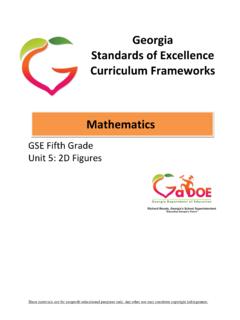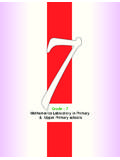Transcription of Plainfield Public Schools Mathematics Grade Unit …
1 PPS Mathematics Curriculum Accelerated 7 Hyperlink noted underlined in italics Plainfield Public Schools Mathematics unit Planning Organizer Grade Accelerated 7 unit of Study unit 4 Geometry Pacing 7 instructional weeks Standards for Mathematical Practices MP1. Make sense of problems and persevere in solving them. MP2. Reason abstractly and quantitatively. MP3. Construct viable arguments and critique the reasoning of others. MP4. Model with Mathematics . MP5. Use appropriate tools strategically.
2 MP6. Attend to precision. MP7. Look for and make use of structure. MP8. Look for and express regularity in repeated reasoning. PPS Mathematics Curriculum Accelerated 7 Hyperlink noted underlined in italics unit STANDARDS Draw (with technology, with ruler and protractor, as well as freehand) geometric shapes with given conditions. Focus on constructing triangles from three measures of angles or sides, noticing when the conditions determine a unique triangle, more than one triangle or no triangle. Describe the two-dimensional figures that result from slicing three dimensional figures, as in plane sections of right rectangular prisms and right rectangular pyramids.
3 Know the formulas for the area and circumference of a circle and use them to solve problems; give an informal derivation of the relationship between the circumference and area of a circle. Use facts about supplementary, complementary, vertical, and adjacent angles in a multi-step problem to write and solve simple equations for an unknown angle in a figure. Solve real-world and mathematical problems involving area, volume and surface area of two- and three-dimensional objects composed of triangles, quadrilaterals, polygons, cubes, and right prisms. Use proportional relationships to solve multistep ratio and percent problems.
4 Examples: simple interest, tax, markups and markdowns, gratuities and commissions, fees, percent increase and decrease, percent error. 4 Use variables to represent quantities in a real-world or mathematical problem, and construct simple equations and inequalities to solve problems by reasoning about the quantities. a. Solve word problems leading to equations of the form px + q = r and p(x + q) = r, where p, q, and r are specific rational numbers. Solve equations of these forms fluently. Compare an algebraic solution to an arithmetic solution, identifying the sequence of the operations used in each approach.
5 For example, the perimeter of a rectangle is 54 cm. Its length is 6 cm. What is its width? b. Solve word problems leading to equations of the form px + q > r or px + q < r, where p, q, and r are specific rational numbers. Graph the solution set of the inequality and interpret it in the context of the problem. For example: As a PPS Mathematics Curriculum Accelerated 7 Hyperlink noted underlined in italics salesperson, you are paid $50 per week plus $3 per sale. This week you want your pay to be at least $100. Write an inequality for the number of sales you need to make and describe the solutions.
6 Verify experimentally the properties of rotations, reflections, and translations: Lines are transformed to lines, and line segments to line segments of the same length. Angles are transformed to angles of the same measure. Parallel lines are transformed to parallel lines. 2. Understand that a two-dimensional figure is congruent to another if the second can be obtained from the first by a sequence of rotations, reflections, and translations; given two congruent figures, describe a sequence that exhibits the congruence between them. Describe the effect of dilations, translations, rotations, and reflections on two dimensional figures using coordinates.
7 Understand that a two-dimensional figure is similar to another if the second can be obtained from the first by a sequence of rotations, reflections, and translations, and dilations; given two similar two-dimensional figures, describes a sequence that exhibits the similarity between them. Use informal arguments to establish facts about the angle sum and exterior angle of triangles, about the angles created when parallel lines are cut by a transversal, and the angle-angle criterion for similarity of triangles. For example, arrange three copies of the same triangle so that the sum of the three angles appears to form a line, and give an argument in terms of transversals why this is so.
8 PPS Mathematics Curriculum Accelerated 7 Hyperlink noted underlined in italics Unwrapped Skills (students need to be able to do) Unwrapped Concepts (students need to know) DOK Levels FOCUS STANDARD: Use proportional relationships to solve multistep ratio and percent problems. Examples: simple interest, tax, markups and markdowns, gratuities and commissions, fees, percent increase and decrease, percent error. Use Solve Proportional Relationships Ratio Percent 2 3 Unwrapped Skills (students need to be able to do) Unwrapped Concepts (students need to know) DOK Levels FOCUS STANDARD: variables to represent quantities in a real-world or mathematical problem, and construct simple equations and inequalities to solve problems by reasoning about the quantities.
9 Use Construct Equations Inequalities 2 3 Unwrapped Skills (students need to be able to do) Unwrapped Concepts (students need to know) DOK Levels FOCUS STANDARD: Solve word problems leading to equations of the form px + q = r and p(x + q) = r, where p, q, and r are specific rational numbers. Solve equations of these forms fluently. Compare an algebraic solution to an arithmetic solution, identifying the sequence of the operations used in each approach. For example, the perimeter of a rectangle is 54 cm.
10 Its length is 6 cm. What is its width? Solve Variable Equations and inequalities 2 3 PPS Mathematics Curriculum Accelerated 7 Hyperlink noted underlined in italics Unwrapped Skills (students need to be able to do) Unwrapped Concepts (students need to know) DOK Levels FOCUS STANDARD: 4b. Solve word problems leading to equations of the form px + q > r or px + q < r, where p, q, and r are specific rational numbers. Graph the solution set of the inequality and interpret it in the context of the problem. For example: As a salesperson, you are paid $50 per week plus $3 per sale.




